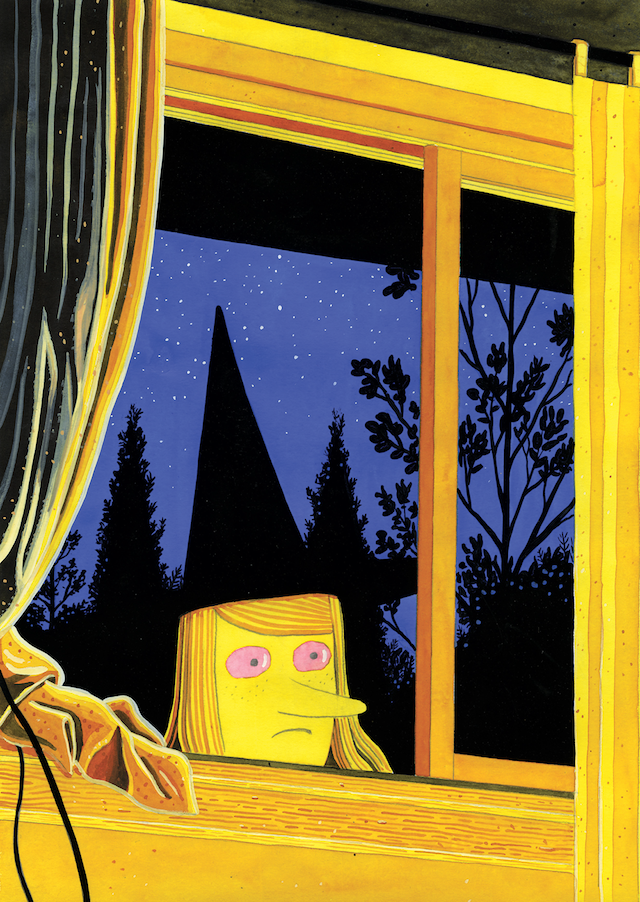Scantily clad probably ain't what you'd use to describe a hag sporting the impracticable design of a caftanesque dress with long sleeves. Though Megg, a green-colored and witch-like manifestation weighed down by several addictions, a beautiful smile, and relying on public welfare, has to strip bare twice in front of the system's incorruptible eyes to ensure further support. This means getting naked for the pestering henchmen of the social services department and shortly afterwards on behalf of some hard-bullying narcs – the first strip happening in a more emblematic but nonetheless painful, if not self-mutilating way – in what would appear as a teenage-angst melodrama, if the protagonists were still in their younger days.
But woe, they aren't, and this is where the actual drama sets in: what do you do if your nasty self-harming habits haven't changed a bit, but your entire surroundings – which include a depicting component revolving around you because of the chosen artform – has? Literally stick with your resinous dreams? Get a lower-class job like notorious drug devourer Werewolf Jones who's mutating into *ack* 'Warehouse Jones'?
You might realize by now that this review is about Simon Hanselmann's latest installment within his creatures-on-the-booze series 'Megg & Mogg'. Bad Gateway, its title, comes along in a typo similar to the font of Australia's black metal heads Woods Of Desolation and truly fits, not just in geographical terms, because of Hanselmann hailing from the Tasmanian neighborhood, but also title-wise on a scale of sentiment. And he shows – namely by one-pagers, character studies drawn in a vein that make you think “when will Hanselmann finally take over the artistic chores of the Trigan Empire” – that he became a real talented painter in the meantime.
 To make proof of this assumption: At the end of the comic there's a section featuring a few illustrated pages, bathing in Van Goghian golden light shining from the inside of a house, while Megg's peering yearningly through a window, arranged in an almost Barksian and duck-oiling way, followed by a spread that exposes the shooting up of heroin. I swear I've never seen a more adequate sequential interpretation of The Strangler's video for Golden Brown done just by using an appropriate coloring. So, getting lost after that in a stoner's garden of green and gray is just the logical consequence, before leaving forever with tears in your eyes, like Megg does on the final page.
To make proof of this assumption: At the end of the comic there's a section featuring a few illustrated pages, bathing in Van Goghian golden light shining from the inside of a house, while Megg's peering yearningly through a window, arranged in an almost Barksian and duck-oiling way, followed by a spread that exposes the shooting up of heroin. I swear I've never seen a more adequate sequential interpretation of The Strangler's video for Golden Brown done just by using an appropriate coloring. So, getting lost after that in a stoner's garden of green and gray is just the logical consequence, before leaving forever with tears in your eyes, like Megg does on the final page.
Now that the stuff doesn't kick in any longer, with a drug-induced depression on the rise and no more coming of H in sight, all the mean-spirited jokes never play out like they used to. It'll be interesting to follow where Hanselmann goes with the direction he's currently heading for; to me it's the first installment in this hodgepodge series that actually made me care about its dramatis personae.
That means he actually writes this gutter ballet ensemble in ways where I no longer see them as simple taxidermied proxies, no, it's Hanselmann getting rid of the partially shattering 'glorious results of a misspent youth' autobio stuff and aiming for even greener pastures. Maybe he should not only get over losing things that will stick with the past anyway, but abandon all the words, too – his nonverbal stuff looks like he's on the trail of something special. Just glance at the impressive cover painting he did for Bad Gateway, still showing elements of an autobiographical attempt by emerging like a mashed-up self portray of him and Megg, while simultaneously visualizing him taking root even deeper within the process of storytelling. And eventually he and his semi-anthropomorphic wrecking crew may become the Carl Barks and Duckburg of our times – as seen through the eye of a needle.








